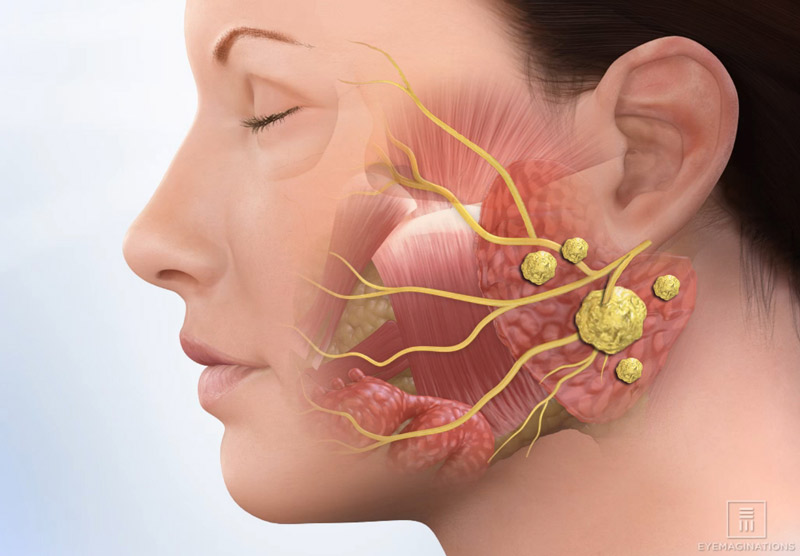The medical term for salivary stones is sialoliths. When they block the salivary glands, this is known as sialolithiasis.
Salivary stones are rarely a cause for concern, and people can often get rid of them at home. However, some stones may require treatment from a doctor.
In this article, we explain what salivary stones are and discuss their symptoms and causes. We also explore home remedies, when to see a doctor, medical treatment, and possible complications.
What are salivary stones?
Salivary stones can form in the ducts of any salivary gland.
Image credit: James Heilman, MD, 2012
The salivary glands in the mouth produce a liquid called saliva. Saliva protects the teeth, helps with chewing and swallowing food, and initiates the process of digestion.
The mouth contains hundreds of minor, or small, salivary glands. There are also three pairs of major, or large, salivary glands. These large glands include the:
- parotid glands, which sit below the ears on the inside of the cheeks
- submandibular glands at the bottom of the mouth near the jawline
- sublingual glands, which are underneath the tongue
Salivary stones are small deposits of calcium and other minerals. They can form in the ducts of any type of salivary gland. Larger stones can block the flow of saliva and cause the glands to swell.
According to research from 2012, more than 80 percent of salivary stones form in the submandibular gland, while 6–15 percent occur in the parotid gland, and 2 percent are in the sublingual and minor salivary glands.
Symptoms
Salivary stones do not usually cause symptoms when they are forming, and they can sometimes disappear on their own. The stones can vary in size, but they are usually hard and white.
Larger stones can block the flow of saliva in the gland. This blockage can cause saliva to build up behind the stone, which can lead to pain and swelling.
Common symptoms of blocked salivary glands include:
- a sore or painful lump under the tongue
- pain or swelling below the jaw or ears
- pain that increases when eating
Salivary stones can sometimes also lead to infection in or around the affected gland. Symptoms of infection can include fever and the formation of pus around the stone.
Causes
Doctors do not fully understand what causes salivary stones. However, certain factors can increase a person's risk of getting them.
These risk factors include:
- being male
- advancing age
- having radiation therapy on the head or neck
- mouth injuries
- taking medications that affect saliva production, such as anticholinergics
- having gout or Sjogren's syndrome
- having kidney problems
- not drinking enough water
Salivary stones are rarely serious, and a person can often treat them at home.
Home remedies for getting rid of salivary stones include:
- Sucking on citrus fruits or hard candies. Sucking on a wedge of lemon or orange increases the flow of saliva, which can help dislodge the stone. A person can also try sucking on sugar-free gum or hard, sour candies, such as lemon drops.
- Drinking plenty of fluids. Regular fluid intake helps keep the mouth hydrated and can increase saliva flow.
- Gentle massage. Gently massaging the affected area may relieve pain and encourage the stone to pass through the salivary duct. The Sjogren's Syndrome Foundation have an illustrated guide on how to do this on their website.
- Medications. Some over-the-counter drugs, such as ibuprofen and acetaminophen, can help relieve pain and swelling.
- Sucking on ice cubes. Sucking on something cold, such as an ice cube or ice pop, may also help reduce pain and swelling resulting from salivary stones.
Medical treatment
Image credit: Wouter Hagens, 2011
The doctor will look inside the person's mouth to examine any painful areas and feel the size and shape of the stones. They may also request an X-ray or CT scan to determine the number of stones and their exact location.
Doctors are sometimes able to massage or press on a salivary stone to dislodge it from the gland. They may also use an ultrasoundmachine, which emits high-frequency sound waves that can break the stone into smaller pieces and make it easier to remove.
Salivary stones that are large or situated deep within the salivary gland may be harder to remove.
In these cases, a doctor may need to perform a sialendoscopy. This procedure involves using an endoscope to examine the inside of the mouth and widen the affected salivary duct, allowing the stone to pass through. As this procedure can be uncomfortable, the doctor will use a local anesthetic to numb the person's mouth first.






